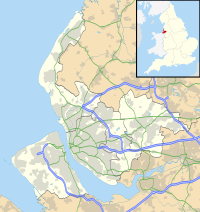Holy Trinity Church, Southport
| Holy Trinity Church, Southport | |
|---|---|

Holy Trinity Church, Southport, from the northeast
|
|
| 53°39′01″N 2°59′48″W / 53.6502°N 2.9967°WCoordinates: 53°39′01″N 2°59′48″W / 53.6502°N 2.9967°W | |
| OS grid reference | SD 342 175 |
| Location | Manchester Road, Southport, Sefton, Merseyside |
| Country | England |
| Denomination | Anglican |
| Website | www |
| History | |
| Consecrated | 12 March 1912 |
| Architecture | |
| Status | Parish church |
| Functional status | Active |
| Heritage designation | Grade II* |
| Designated | 15 November 1972 |
| Architect(s) | Huon Matear |
| Architectural type | Church |
| Style | Gothic Revival (Decorated) |
| Groundbreaking | 1904 |
| Completed | 1913 |
| Specifications | |
| Length | 157 feet (47.9 m) |
| Width | 70 feet (21.3 m) |
| Spire height | 142 feet (43.3 m) (tower) |
| Materials | Red brick, Bath stone, Portland stone, Slate roofs |
| Administration | |
| Parish | Holy Trinity, Southport |
| Deanery | North Meols |
| Archdeaconry | Warrington |
| Diocese | Liverpool |
| Province | York |
| Clergy | |
| Vicar(s) | Revd Canon Dr Rod Garner |
| Curate(s) | Revd Jane Morgan |
| Laity | |
| Reader(s) | Bob Neate, Sue Palmer, Toni Ashcroft |
| Director of music | Ian Wells |
| Churchwarden(s) | Brian Stone, Anne Tudor |
Holy Trinity Church is in Manchester Road, Southport, Sefton, Merseyside, England. It is an active Anglican parish church in the diocese of Liverpool and is recorded in the National Heritage List for England as a designated Grade II* listed building. The church was built during the early years of the 20th century, and was designed by Huon Matear in free Decorated style. It is constructed mainly in red brick, and has a tower, the upper parts of which are in elaborately decorated stone. Many of the internal furnishings are by the Bromsgrove Guild.
Southport did not develop as a town until the later part of the 18th century, before which the area contained only scattered dwellings and small settlements, the main one of which was Churchtown. The area containing the present Holy Trinity Church was in the parish of St Cuthbert, Churchtown, until 1821 when Christ Church was built. At his time the local congregation met in a simple thatched building known as Halls Chapel. As the population in the area grew it became evident that a more substantial building was needed, and the first Holy Trinity Church was built in 1836. This was consecrated on 1 November 1837 by the Rt Rev John Sumner, bishop of Chester. The church was a small structure with a tower, measuring 58 feet 6 inches (17.8 m) by 45 feet 6 inches (13.9 m). In 1840 an organ and gallery were installed in it, the church was extended to the east by 12 feet (3.7 m) and a clock was added to the tower in 1847. There were further extensions in 1860–62.
Later in the century this church was becoming too small for the size of the congregation, and in 1893 a meeting was held to consider plans for a new church on the same site. The Liverpool architect Huon Matear was appointed to design it. On 1 November 1903 a contract was signed with Woods of Bolton to build the nave, and the foundation stone was laid on 12 January 1904 by Mrs Elder, a member of the family running the Elder shipping company. The completed nave was dedicated on 15 December 1904 by the Rt Rev Francis Chavasse, bishop of Liverpool. Work on the rest of the church continued, the transept and two porches being dedicated on 28 January 1911, and when the body of the church was completed it was consecrated on 12 March 1912. At his time the tower was not finished; this was completed by 15 February 1913. The cost of building the church was met by donations from local people in what the authors of the Buildings of England series call an "amazing tour-de-force of Edwardian patronage". The Elder family paid for the nave, the tower and the west front, Joseph Mullineaux Dewhurst, a cotton manufacturer, paid for the chancel, and the cost of the Lady Chapel was met by W. B. Taylor and J. A. Grundy.
...
Wikipedia

